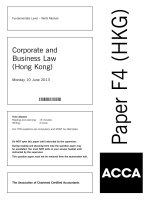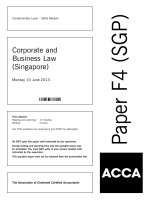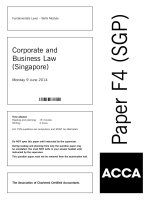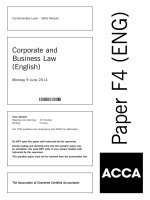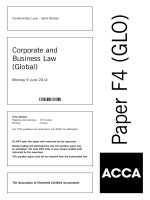ACCA f4 corporate and business law vietnam 2012 jun a
Bạn đang xem bản rút gọn của tài liệu. Xem và tải ngay bản đầy đủ của tài liệu tại đây (86.79 KB, 10 trang )
Answers
Fundamentals Level – Skills Module, Paper F4 (VNM)
Corporate and Business Law (Vietnam)
1
June 2012 Answers
The question asked candidates to explain the sources of law in Vietnam, and to explain the significance of judicial independence.
(a)
The highest source of law in Vietnam is the Constitution. This lays down the rights and obligations of citizens, guarantees
their human rights and defines the structure through which state institutions, such as the government, the administration and
the judiciary must operate.
Vietnam’s legal system is a codified (or civil) law system. This means that laws are written down definitively, anticipating
matters that have to be defined or resolved in society. The main sources of primary law are legal codes and legislative acts.
Legal codes build on the Constitution and set principles and regulations relating to various spheres of human interaction. The
Civil Code is the most important of these, as it defines the legal rights and obligations of individuals and legal entities.
Legislative acts are more detailed. The most important legislative act in respect of entrepreneurial activity is the Law on
Enterprises, which governs how individuals and legal entities must be registered as well as how they must be managed and
administered.
Legal codes and legislative acts are proposed by the National Assembly and implemented by the government.
Decrees may be issued by the government on specific aspects of primary legislation.
As it is impossible for legal codes and legislation to be altered quickly to respond to change, the government empowers
ministries and other state agencies to enact regulations and guidelines. These provide an additional source of law, enabling
primary legislation to be interpreted and implemented in a manner that is consistent with their underpinning intentions. As a
result, the provisions of written laws are reinforced by many circulars and official letters.
A lesser but fundamental source of law is custom and tradition. This source is most likely to influence an outcome when the
court considers that the most appropriate resolution of a case may be brought about by respecting local tradition, though this
may only be done if such an outcome is consistent with formal codes and laws.
Finally, as Vietnam is a signatory to many international treaties and conventions, these are a source of law in themselves. As
the government’s actions must be consistent with the Constitution of Vietnam, it is necessary for the content of treaties and
conventions to be consistent with the provisions contained in the Constitution.
(b)
Judicial independence in Vietnam is guaranteed by Article 130 of the Constitution. This states that ‘During trials, judges and
people’s assessors are independent and subject only to the law.’ The principle is reinforced by Article 136, which states that
the verdicts of the judiciary must be respected.
The three main organs of government are the legislature, which makes laws, the administration (or executive), which puts
the law into effect, and the judiciary, which applies the law on behalf of the state. In most but not all countries, these three
organs operate independently of one another, which is sometimes referred to as a system of ‘check and balance’. This is the
principle of the ‘separation of powers’.
It is necessary for the judiciary to be independent in order to ensure that the law is applied objectively and fairly, free from
inappropriate influences from individuals and institutions. The courts rely on judges to interpret legislation and apply it to
resolve cases put before them. In the absence of a direct law to determine a given situation, the judges may also be called
upon to decide cases according to their understanding of the intention of the law.
If the judiciary was not independent, it would be possible for those in positions of power to use the law for their own ends,
which may not always be in the best interests of the state, and by inference, the citizens of Vietnam, whose constitutional
rights could be jeopardised.
2
The question asked candidates to explain any five means of securing obligations as set out in the Civil Code.
Article 318 of the Civil Code lists seven means of securing obligations.
(i)
Pledge:
A pledge of property is the delivery of an asset belonging to one person (the pledgor) to another person (the pledgee) in order
to secure the obligation. If the pledgor does not fulfil the primary obligation, the pledged property can be sold in order to satisfy
the obligation. The pledge can be for any period of time. It does not confer absolute rights over the item of pledge, however,
as the pledgee must preserve the property and not exploit it without the consent of the pledgor.
A pledge contract must be made in writing. It may be a separate document, or may be contained within the primary
agreement between debtor and creditor.
(ii)
Mortgage:
A mortgage is similar in character to a pledge but does not involve delivery of the asset to the mortgagee. Although mortgage
contracts are often used in respect of real estate, it is possible to create a mortgage over both movable and immovable
property. When the mortgaged asset is real estate, the mortgage is subject to additional laws relating to immovable property.
Mortgage contracts must be executed in writing and notarised.
7
(iii) Performance bond:
A performance bond is a sum of money, precious metals, gemstones or other valuable items, delivered by one party to another
to secure an obligation. If the obligation is not fulfilled, the performance bond property belongs to the recipient of the bond.
If the recipient of the bond refuses to enter into or perform the contract, the performance bond property must be returned and
a money amount equivalent to the value of the performance bond property must be paid to the party that delivered the bond.
A performance bond must be recorded in writing.
(iv) Security deposit:
A security deposit is a sum of money, precious metals, gemstones or other valuable items delivered by a lessee of movable
property to the lessor as security for the return of the leased property. On return of the leased property, the security deposit
property is returned, subject to deduction of any outstanding monies owed, such as rent. If the lessee does not return the
leased property, the lessor is able to reclaim it, but if this is impossible, the lessor is entitled to keep the security deposit
property.
(v)
Escrow deposit:
An escrow deposit is the placement of money, precious metals, gemstones or other valuable papers into an escrow account
at a bank as security for the performance of an obligation. If the obligation is not performed, or is performed incorrectly, the
obligee is entitled to be paid by the bank where the deposit is held, subject to deduction of bank charges. The obligee can
also claim for any damage caused.
(vi) Guarantee:
A guarantee is a promise by a third party (or more than one third party) to discharge the obligation of a debtor in the event
that the debtor fails to fulfil an obligation. In effect, two contracts are created. The primary contract is between the debtor and
the creditor and the secondary contract is between the guarantor and the creditor.
All guarantees must be made in writing, either as a constituent party of the debtor–creditor contract or as a separate
document. Some guarantees must be notarised.
(vii) Fidelity guarantee:
A fidelity guarantee is a promise by a socio-political organisation operating at a local level to enable poor individuals and
households to borrow from financial institutions for the purposes of production, business or the provision of services. These
guarantees must be made in writing.
3
The question required an explanation of the three types of labour contract as set down in the Labour Code, and an explanation of
the limitations that apply to each.
Article 26 of the Labour Code defines a labour contract as an agreement between an employer and an employee on the paid job,
working conditions and the rights and obligations of each party in the labour relationship. Article 27 then defines three types of
labour contract.
An indefinite term labour contract is one in which the two parties do not decide on a time for the termination of the contract. It is
in effect an open-ended contract that may be terminated by either party, subject to conditions laid down in the contract itself, and
the provisions of the Labour Code.
A definite term labour contract is one in which the two parties agree that the contract will be terminated on a future specific date,
with the validity of the contract being between 12 and 36 months.
A labour contract for a specific or seasonal job is a special form of definite term labour contract, with a duration of less than
12 months.
The Labour Code is relatively non-prescriptive in relation to indefinite term contracts. However, several conditions apply to contracts
with a definite term.
If on the expiry date of a definite term contract or seasonal contract the employee continues to work, the two parties must enter
into a new contract within 30 days. If no new contract is created, the definite term contract or seasonal contract becomes an
indefinite term labour contract.
If a definite term contract expires, it is only possible to enter into a new definite term contract once. If the employee continues to
work at the end of the second contract, he or she must be employed under an indefinite term labour contract.
Specific or seasonal contracts cannot be entered into for regular jobs that have a duration of more than 12 months. The exception
to this is where a vacancy due to military service, pregnancy or other temporary reasons must be filled.
Article 28 of the Labour Code permits the engagement of temporary workers and domestic servants by oral agreement for periods
of less than three months. All other types of labour contract must be in writing.
All labour contracts must be entered into directly by the employer and the employee. The latter is not permitted to assign the tasks
envisaged by the contract to a third party.
8
4
The question tested the candidates’ knowledge of the meaning and significance of separate legal personality.
Separate legal personality refers to the existence of an enterprise as a distinct entity, separate from both those who own it (the
shareholders) and those who manage it. Once incorporated through the issuance of a business registration certificate by the State
authorities, the company becomes, in effect, an artificial legal ‘person’.
As far as the owners are concerned, any investments they make in cash or other assets become the capital of the company and
their shares represent a claim against these assets. Put simply, an individual who owns 10% of the shares in a company does not
own 10% of its various types of asset but does have the right to 10% of the residual value should the enterprise cease to exist.
Under the provisions of the Law on Enterprises, this claim is subordinated to the claims of others, so in insolvent liquidation the
company will not be able to return the initial investment in full.
Separate legal personality gives the legal entity perpetual succession, as it can continue to operate beyond the lifespan of the
shareholders. Ownership of the enterprise is therefore transient, as shareholders transfer or bequeath their shares to their
successors.
Separate legal personality means that the company can own assets and create liabilities on its own behalf, and as such is
accountable for the latter. The shareholders cannot be held liable for any sum over and above their investment (with some legal
exceptions), as they enjoy the protection of limited liability.
The company can also generate its own income and expenditure. Any profit generated by the company may be retained or
distributed to the shareholders, according to the recommendation of the board, sanctioned by the shareholders in a general
meeting.
The company can take legal action and can also be subject to litigation in its own name. Such action may be instigated by the
shareholders of the company, or more often by the senior management deciding to do so. Even if the company is in insolvent
liquidation, a liquidator may take action on behalf of the company. He or she may do so, for example, if action for recovery of an
unpaid receivable has a prospect of increasing the funds available for distribution.
There are limited circumstances in which the owners or managers can be exposed to litigation for the actions or inactions of the
company. These include instances in which fraudulent behaviour has taken place. However, when losses arise due to the
inappropriate commercial decisions of executive bodies, it is normally the company itself that bears the impact.
5
The question tested the candidates’ knowledge of the differences between the legal relationship that a company has with its
shareholders to that which it has with providers of long-term capital.
A shareholder is an owner of an interest in a company. This provides four sets of rights and obligations.
Firstly, the shareholder has rights and obligations in respect of capital. By agreeing to become a shareholder, the investor
undertakes to provide permanent capital for the company (Articles 42 and 80, Law on Enterprises). The company must return the
capital on liquidation, subject to the priority claims of others. In relation to redeemable shares, the company must pay the capital
back subject to the conditions applicable to the specific security and in a manner consistent with Article 83 of the Law on
Enterprises.
Secondly, the shareholder has a right to a return on the capital provided through the payment of dividends when declared, but the
dividends are subject to the company having profits that may be distributed (Articles 61 and 93, Law on Enterprises).
Thirdly, the shareholder has extensive constitutional rights to participate in the management of the company by attending general
meetings, proposing items for discussion and voting. Shareholders may also convene general meetings, subject to ownership
thresholds determined by the Law on Enterprises or contained in the Charter.
Lastly, the shareholder has right to be provided with information on the company, such as its financial statements, its management
and its constitutional documents (Article 129, Law on Enterprises).
Those who provide long-term capital in the form of loans have a debtor–creditor relationship with the company, governed mainly
by the laws on civil obligations as contained in part three of the Civil Code. In relation to bonds issued by shareholding companies,
restrictions on the company are set out in Articles 88 and 89 of the Law on Enterprises.
The creditors of the company are entitled to be repaid their capital according to the terms of the contract. Therefore, this capital is
not ‘permanent’. If the company is liquidated, creditors have priority of repayment ahead of the shareholders.
The return on capital provided by creditors is interest, and not dividends. The interest rate is decided by the parties to the contract,
and must be paid irrespective of whether the company is profitable or not. In contrast with the shareholders, whose dividends are
limited by law and financial performance, creditors have greater certainty of receiving a return on their investment.
Creditors have no constitutional rights in the company as their relationship is not one of membership. However, if a company is
insolvent, the creditors may assert their rights to pursue the company for monies owed through the committee for management
and liquidation of funds. The shareholders have no such rights, except where they are also shareholders.
Creditors may have a right to financial and other information produced by the company, and those who provide significant loan
capital will certainly require such information as a condition of the investment. Long-term loan contracts may include financial and
non-financial covenants under which the company agrees to provide annual or other periodic statements, reports or certificate of
compliance with the conditions of the lending agreement.
9
6
The question required an explanation of how the Inspection Committee is appointed, the criteria for membership of the Inspection
Committee, and its duties and powers.
(a)
Article 121 of the Law on Enterprises specifies that the Inspection Committee shall comprise 3–5 members with a maximum
term of service of five years. The members of the committee may be re-elected for unlimited terms. One member of the
committee is elected as its head. At least half of the membership of the committee must be Vietnamese residents, and at least
one member must be an accountant or auditor.
Though employed by the company, the members of the committee operate independently of management. Article 122 of the
Law on Enterprises lays down conditions for membership of the committee, reinforcing its independence. Individual members
must be at least 21 years of age, have full legal capacity and not be prohibited from serving on the committee. They must
not be closely related to members of the board of management, the general director or other managers. They may not hold
managerial positions in the company.
(b)
The duties and powers of the Inspection Committee are laid down in Article 123 of the Law on Enterprises.
The Inspection Committee is an oversight body, providing important internal control services on behalf of the shareholders.
The duties and powers of the committee are as follows.
Inspection and review:
The committee supervises the board of management in their duties concerning the management and administration of the
company. It is responsible for ascertaining whether the financial and statistical information produced by the company is
reasonable and truthful. In discharging these duties the committee reviews books of account and documents of the company.
This may take place through internal procedures and on request of the general meeting of shareholders, or any shareholder
or group of shareholders. If such a request is made by the shareholders, the committee must carry out its enquiries within
seven days and report back within 15 days of completion of the investigation. In carrying out its work, the committee may
not disrupt the normal operations of the company.
Reporting:
As its primary duty is to the shareholders, the committee must make a report to the general meeting of shareholders each
year, based on its review of information produced by the company. The report must include an evaluation of the financial
statements and the performance of the board of management.
The committee may make recommendations to the shareholders or to the board of management on changes or improvements
in respect of the organisational structure, management and administration. It may consult the board of management before
submission of such reports to the shareholders.
Enforcement and compliance:
If the committee finds that the board of management, general director or director are in breach of their obligations, the
committee may give immediate written notice of this to the board of management and insist that the breach be remedied.
Further rights of enforcement may be available under provisions contained in the Charter of the company or by resolutions of
the shareholders
7
The question asked candidates to explain the meaning of the term ‘insolvency’, and to explain the provisions of the Law on
Bankruptcy in respect of parties that can instigate a petition for bankruptcy proceedings.
(a)
In a financial context, the term ‘insolvency’ refers to a situation when an organisation’s total liabilities exceed its total assets,
thereby making it impossible in anything but the short-term to continue business operations.
Article 3 of the Law on Bankruptcy provides the following definition: ‘Any enterprise or cooperative which is unable to pay its
due debts on demand by a creditor shall be deemed to have become insolvent.’
The statutory definition widens the meaning of the term somewhat, as organisations that are unable to pay their due debts
may be illiquid rather than technically insolvent. This may be due to fluctuations in the business cycle, seasonality or
difficulties in pursuing debtors.
Article 28 of the Law on Bankruptcy empowers the court to decide whether an enterprise is insolvent or not, and indeed
compels the court to take a decision on this within 30 days of receipt of the petition. The law is silent on the factors that will
be considered by the court, but in practice the court must consider whether the enterprise will be able to meet its obligations
in the foreseeable future, and whether permitting the enterprise to continue its business operations will worsen the position
of the creditors.
(b)
Article 13 states that any unsecured or partly secured creditor that observes that a company has become insolvent may
petition the court to commence bankruptcy proceedings. The petition must include the date, the particulars of the debtor and
creditor, the due debt and the grounds for pursuit of the debt through the court.
Article 14 empowers employees to bring a petition to commence bankruptcy proceedings if wages or other monies due to
employees are unpaid. The petition is submitted by a representative of the workforce, elected by a majority of more than
10
one-half the number of employees or by collection of signatures. The petition must include the date, the particulars of the
parties, the number of months of unpaid wages or details of other monies due and the grounds for pursuit of the debt through
the court.
If the management of an enterprise is aware that it is insolvent, Article 15 compels them to petition for bankruptcy. Again,
the petition must include the date and the names of the parties, but must also be supported by a detailed report on the
background to the insolvency and the measures taken to avert it. If the company has external auditors, the report must be
certified by them. The enterprise must also submit a full list of creditors and debtors, including amounts and due dates, as
well as information on whether debts are secured or unsecured. Article 16 makes similar provisions in respect of State-owned
enterprises.
Article 17 enables the shareholders of an enterprise to submit a petition to commence bankruptcy proceedings. Their action
must be compliant with any provisions in the Charter for such action, but if the Charter does not include this information, the
petition may be approved by a general meeting of shareholders. If a meeting cannot be held, the petition may be moved by
shareholders owning more than 20% of the shares for a minimum of six months.
Under Article 18, in respect of partnerships, any partner may submit a petition to commence bankruptcy proceedings. The
petition must be supported by a report setting out similar details to those required under Article 15.
8
The question asked candidates to apply their knowledge of contract law to a case study scenario in which a builder did not
complete home improvement work according to the conditions set down in a contract. Part (a) required a consideration of the
consequences of abandoning the job for more remunerative work. Part (b) required a consideration of the consequences of
abandoning the job due to an unexpected family illness.
(a)
Article 302(1) of the Civil Code states that an obligor who fails to perform, or performs incorrectly, an obligation has civil
liability to the obligee. Article 308 amplifies this, stating that failure to perform an obligation, or incorrect performance of an
obligation, is regarded as a breach of a civil obligation even if it is unintentional. In the scenario, partial completion of the
home improvement must be regarded as failure to perform the obligation, as the unfinished work is clearly unsatisfactory from
her perspective.
If Bao failed to perform the work as specified in the contract and walked away from the job simply because he could get more
lucrative work elsewhere, it is clear that this is an intentional breach of the obligation. Article 304 sets down the consequences
of this. Under this Article, Khanh can insist that Bao completes the work that he started, or alternatively assign the work to
another person. As the obligor, Bao must pay reasonable costs and expenses, and compensate for any damage. Bao would
almost certainly be liable for such compensation, as he was unprepared to refer Khanh to an alternative builder to complete
the work.
Article 307 elaborates on payment of damages. These may comprise physical or financial losses, and also spiritual losses
where appropriate.
In the scenario, as Khanh’s expenditure was 50% greater than envisaged in the original contract, she can claim this financial
loss from Bao, assuming she has take reasonable steps to mitigate her loss. She can also claim for the costs of bringing a
legal action against him.
(b)
Small traders are especially vulnerable to unexpected events that may disrupt their ability to carry out work as scheduled in
a contract. To pre-empt this eventuality, it is common to include clauses in contracts that permit withdrawal under stated
circumstances.
Those who fail to anticipate such problems run the risk that they may have to rely on the court’s interpretation of whether the
event is one of force majeure. This concept is embodied in Article 302(2) of the Civil Code, which states that the inability to
perform a contract due to an event of force majeure precludes any civil liability falling upon the obligor, unless otherwise
agreed by the parties or provided for by law.
Superficially, the sudden illness of a family member would appear to be an event of force majeure, but this might not be the
case in this scenario.
Even assuming that Bao have no other family members to help out with the care of his mother, the court could take the view
that her illness might reasonably be foreseen and that Bao should have made contingency plans for such an occurrence.
Bao has been unwilling to assist Khanh in securing the services of an alternative builder to complete the work. It would be
extremely unlikely for a builder not to have contacts in the building trade, and less likely that he would not have any
knowledge at all of alternative providers. This could of course depend on the size of the business community in which Bao
operates. His case would be stronger if his business was located in an isolated village, with no other builders working in the
area.
In order to discharge the contract without financial consequences under the provisions of Article 302(2), Bao would have to
demonstrate that it was both impossible for him to complete the work and also impossible to assign the work to another
person, as required under Article 304(1).
11
9
The question was a scenario in which the starting time of a general meeting of shareholders was delayed due to unforeseen
problems in accommodating the number of shareholders present. It asked candidates to apply their knowledge of the constitutional
rights of shareholders, as well as their knowledge of the provisions contained in the Law on Enterprises in relation to general
meetings of shareholders.
(a)
Any application to the court to cancel resolutions passed at a general meeting must be submitted within 90 days of the
adoption of the resolution at the meeting. The application can be made by any shareholder, member of the board of
management or member of the Inspection Committee.
The court may set aside any resolution if it contravenes the order or procedure for convening the meeting, or if the content of
the resolution is contrary to the law or contents of the charter of the company.
(b)
The statutory requirements in respect of the conduct of general meetings of shareholders are set out in Articles 96 to 107 of
the Law on Enterprises.
Article 100 requires the company to despatch an invitation to shareholders eligible to attend a general meeting no later than
seven working days prior to the meeting. The question turns to some extent on whether the reconvened general meeting was
a new meeting that did not have the required seven days notice, or an adjournment of an existing meeting.
Article 99 obliges the convenor of the general meeting to provide the shareholders eligible to attend with a programme and
agenda of matters to be discussed.
All shareholders eligible to attend and vote at meetings should have a reasonable expectation of being able to participate.
However, the Law on Enterprises anticipates that meetings may have to be adjourned.
Specifically, Article 103(8) empowers the chairman to adjourn the general meeting of shareholders to another time or location
if:
(1) The location for the meeting does not have adequate seating for all the attendees.
(2) There is an attendee who obstructs the meeting or disrupts order, and that there is a danger that the meeting might not
be conducted fairly and legally.
The maximum time for such an adjournment is three days from the date of the proposed opening of the meeting.
As the meeting was adjourned for only three hours due to the inadequacy of the seating arrangements, the chairman acted
lawfully in going ahead at a later starting time.
The board of management could also legitimately argue that as the agenda for the meeting included controversial matters that
would have been known to the shareholders in advance, it would be reasonable to expect the meeting to go on into the
afternoon.
The dissentient members who objected to the reconvening of the meeting at the later starting time collectively held 25% of
the voting shares in the company. This would be sufficient to demand that a new meeting be held, as Article 79(2) empowers
a shareholder or any group of shareholders holding more than 10% of the shares of the company to do so.
10 The question asked candidates to analyse a scenario in which a company proposed a dividend payment, having made losses in
2008 and 2009, then a profit in 2010. It required an understanding of the provisions of the Law on Enterprises in relation to
dividends and directors’ obligations.
(a)
Dividends are the annual return to shareholders on the permanent risk capital they provide for the enterprise. They are
recommended to the general meeting of shareholders by the board of management. In reality, this is rather more than a
‘recommendation’, as the shareholders cannot award themselves a higher dividend than that struck by the board.
It is a principle of company law that the capital in a company should be maintained in order to provide a creditors’ buffer.
Those who do business with the company, including its shareholders and creditors, should be entitled to peruse the financial
statements and assume that the company will preserve the level of capital to protect against unforeseen losses and maintain
their confidence. There are many legitimate reasons for a company proposing a reduction in capital, but such reductions may
only be effected in the manner prescribed in the Law on Enterprises.
Article 93(2) of the Law on Enterprises states that dividends paid to ordinary shareholders shall be determined on the basis
of the net profit and that payments for dividends must be sourced from profits retained by the company. Further, the company
may only pay dividends if it has fulfilled its tax and other financial obligations and fully covered previous losses, including
contributions to established corporate funds. In effect, this means that the maximum dividend payable comprises net
realisable gains less net realisable losses.
Applying these rules to the scenario, YWS Company’s profit of 48 million dong is not available for distribution, as the previous
years’ total losses of 32 million dong (20 million dong in 2008 and 12 million dong in 2009) must be taken into account
when calculating the maximum dividend payment. Therefore, the company may distribute a maximum of 16 million dong.
The revaluation of non-current assets of 80 million dong has an effect on the worth of the company, but this cannot be taken
into account in the calculation of the maximum dividend payable, as it is not sourced by retained profits.
The proposal to pay a dividend of 64 million dong is illegal.
12
(b)
Article 94 of the Law on Enterprises lays down the consequences of paying illegal dividends. It states that dividends other
than those paid in accordance with Article 93 must be repaid by shareholders who receive such dividends, whether they were
received in cash or other assets.
If a shareholder cannot pay back these dividends, the shareholders and the board of management are jointly liable for the
debts of the company to the extent of the monies or assets that have been paid to them.
The practical impact of this is that Giang and Hung will be liable for the excessive dividend of 48 million dong if this cannot
be reclaimed from the shareholders.
13
Fundamentals Level – Skills Module, Paper F4 (VNM)
Corporate and Business Law (Vietnam)
1
June 2012 Marking Scheme
(a)
Constitution
Codes
Legislative acts
Secondary legislation, guidelines
International law
Custom and tradition
1 mark
1 mark
1 mark
Up to 2 marks
1 mark
1 mark
(7 marks)
(b)
Separation of powers
Definition and importance of independence
1 mark
Up to 2 marks
(3 marks)
(Total 10 marks)
2
Pledge
Mortgage
Performance bond
Security deposit
Escrow deposit
Guarantee
Fidelity guarantee
Up to 2 marks
Up to 2 marks
Up to 2 marks
Up to 2 marks
Up to 2 marks
Up to 2 marks
Up to 2 marks
(Total 10 marks)
3
Definition of types of contract
Rules relating to definite term contracts
Rules relating to seasonal contracts
1 mark for each of the three types
Up to 4 marks
Up to 3 marks
(Total 10 marks)
4
Meaning of separate legal personality
Implications for ownership
Perpetual succession
Assets and liabilities
Income and expenditure
Litigation
Up to 2 marks
Up to 2 marks
Up to 2 marks
Up to 2 marks
Up to 2 marks
Up to 2 marks
(Total 10 marks)
5
Differences in relation to the contractual relationship
Permanency of capital
Dividends and interest
Constitutional rights
Rights to information
Information rights
Rights on liquidation
1 mark
1 mark
Up to 3 marks
Up to 2 marks
1 mark
1 mark
1 mark
(Total 10 marks)
6
(a)
Appointment
Criteria for membership
Up to 2 marks
Up to 2 marks
(4 marks)
(b)
Per power/duty
1 mark, maximum 6 marks
(6 marks)
(Total 10 marks)
15
7
8
9
(a)
Meaning of insolvency
Up to 2 marks
(2 marks)
(b)
Right of creditors
Right of employees
Obligation of management
Right of shareholders
Right of partners
Up to 2 marks
Up to 2 marks
2 marks
1 mark
1 mark
(8 marks)
(Total 10 marks)
(a)
Statement of the law relating to breach of contract
Application to scenario
Up to 2 marks
Up to 3 marks
(5 marks)
(b)
Discussion of impossibility of performance
Application to scenario
Up to 2 marks
Up to 3 marks
(5 marks)
(Total 10 marks)
(a)
90 day limit and parties who may petition the court
Improper order or process and contrary to law or charter
1½ marks
1½ marks
(3 marks)
(b)
General provisions of law on meetings
Rights to adjourn
Right of dissentient shareholders to convene meeting
Application to scenario
1 mark
2 marks
1 mark
3 marks
(7 marks)
(Total 10 marks)
Statement of law on dividends
Use of financial information in the question
Application to scenario
Up to 2 marks
Up to 2 marks
Up to 3 marks
(7 marks)
Liability of shareholders
Liability of board of management
Up to 1½ marks
Up to 1½ marks
(3 marks)
(Total 10 marks)
10 (a)
(b)
16

